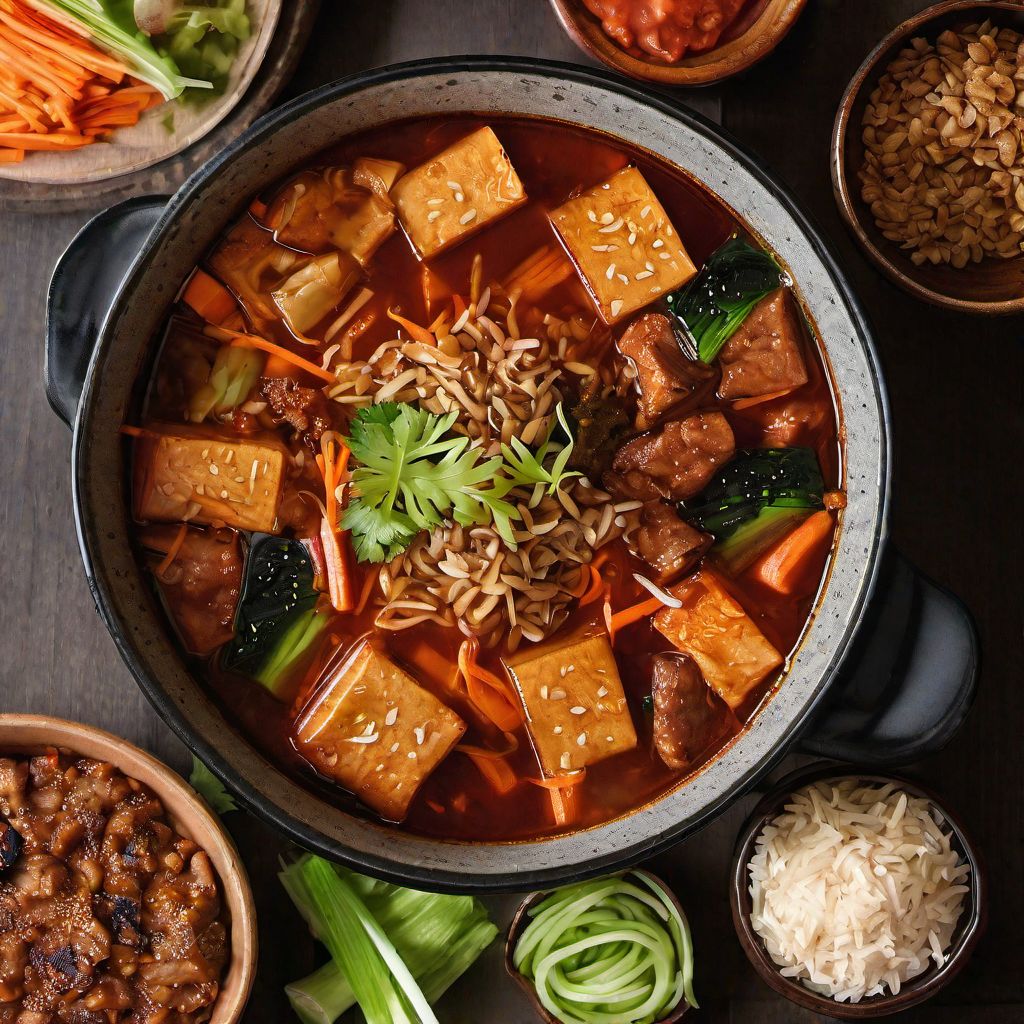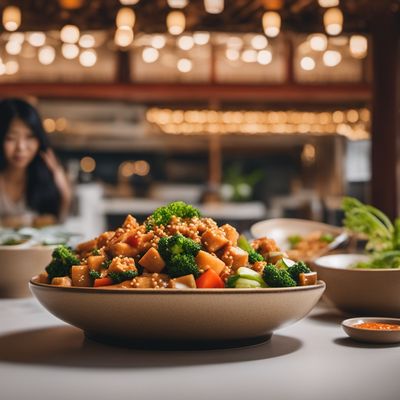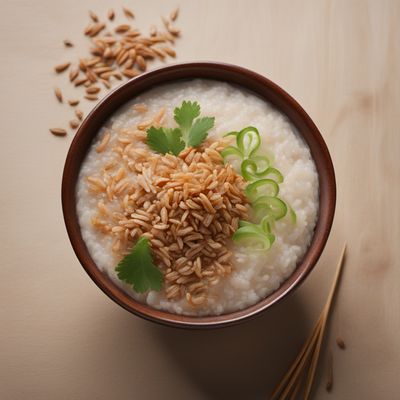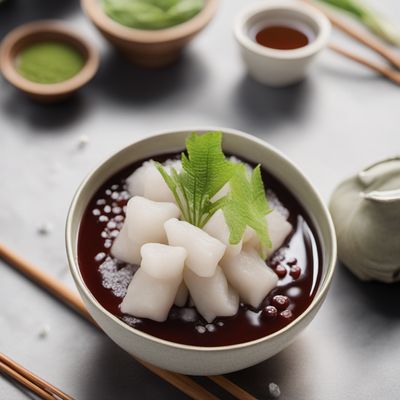
Recipe
Budae Jjigae - Japanese Style
Umami-packed Budae Jjigae: A Fusion of Korean and Japanese Flavors
4.7 out of 5
In the realm of Japanese cuisine, Budae Jjigae, a popular Korean dish, has found its way onto the tables of many Japanese households. This hearty and comforting stew combines the best of both worlds, blending the umami-rich flavors of Japanese ingredients with the spicy kick of Korean cuisine. Get ready to indulge in a unique culinary experience that harmonizes the two cultures.
Metadata
Preparation time
20 minutes
Cooking time
20 minutes
Total time
40 minutes
Yields
4 servings
Preparation difficulty
Medium
Suitable for
Pescatarian, Dairy-free, Gluten-free (if using gluten-free miso and soy sauce), Nut-free, Low-calorie option available
Allergens
Soy, Wheat (if using regular miso and soy sauce)
Not suitable for
Vegan, Vegetarian, Paleo, Keto, High-protein diet
Ingredients
While the original Korean Budae Jjigae features a combination of Korean ingredients like gochujang and kimchi, the Japanese adaptation incorporates Japanese ingredients to create a distinct flavor profile. The Japanese version often includes ingredients such as miso paste, dashi stock, and Japanese sausages, giving the dish a unique umami taste that is characteristic of Japanese cuisine. We alse have the original recipe for Budae jjigae, so you can check it out.
-
2 cups (470ml) dashi stock 2 cups (470ml) dashi stock
-
2 tablespoons miso paste 2 tablespoons miso paste
-
1 tablespoon soy sauce 1 tablespoon soy sauce
-
1 tablespoon gochujang (Korean chili paste) 1 tablespoon gochujang (Korean chili paste)
-
1 tablespoon sesame oil 1 tablespoon sesame oil
-
1 onion, thinly sliced 1 onion, thinly sliced
-
2 cloves garlic, minced 2 cloves garlic, minced
-
1 carrot, sliced into thin strips 1 carrot, sliced into thin strips
-
1 cup (150g) sliced Japanese sausages 1 cup (150g) sliced Japanese sausages
-
1 cup (200g) sliced tofu 1 cup (200g) sliced tofu
-
1 cup (200g) sliced shiitake mushrooms 1 cup (200g) sliced shiitake mushrooms
-
1 cup (200g) napa cabbage, chopped 1 cup (200g) napa cabbage, chopped
-
1 cup (200g) kimchi 1 cup (200g) kimchi
-
1 cup (200g) instant ramen noodles 1 cup (200g) instant ramen noodles
-
2 green onions, chopped 2 green onions, chopped
-
1 tablespoon toasted sesame seeds 1 tablespoon toasted sesame seeds
Nutrition
- Calories (kcal / KJ): 350 kcal / 1465 KJ
- Fat: 15g / 23% (Saturated Fat: 4g / 20%)
- Carbohydrates: 40g / 15% (Sugars: 6g)
- Protein: 15g / 30%
- Fiber: 5g / 20%
- Salt: 2g / 33%
Preparation
-
1.In a large pot, heat sesame oil over medium heat. Add onion and garlic, and sauté until fragrant.
-
2.Add carrot, Japanese sausages, tofu, shiitake mushrooms, napa cabbage, and kimchi. Stir-fry for 2-3 minutes.
-
3.In a small bowl, whisk together dashi stock, miso paste, soy sauce, and gochujang until well combined.
-
4.Pour the mixture into the pot and bring to a simmer. Cook for 10 minutes to allow the flavors to meld together.
-
5.Meanwhile, cook the instant ramen noodles according to package instructions. Drain and set aside.
-
6.Add the cooked noodles to the pot and stir gently to combine.
-
7.Serve the Budae Jjigae hot, garnished with chopped green onions and toasted sesame seeds.
Treat your ingredients with care...
- Japanese sausages — Look for sausages with a good balance of fat and meat for the best flavor.
- Dashi stock — If you can't find dashi stock, you can substitute it with vegetable or chicken broth.
- Miso paste — Choose a mild or medium miso paste for a balanced flavor in the stew.
- Gochujang — Adjust the amount of gochujang according to your spice preference.
- Kimchi — Use well-fermented kimchi for a tangy and flavorful taste.
Tips & Tricks
- For an extra umami boost, add a handful of dried shiitake mushrooms to the broth while simmering.
- Customize the ingredients by adding other Japanese favorites like sliced kamaboko (fish cake) or enoki mushrooms.
- Adjust the spiciness by adding more or less gochujang according to your taste preference.
- To make it heartier, you can add cooked udon noodles instead of ramen noodles.
- Leftovers can be stored in the refrigerator for up to 3 days. The flavors will continue to develop, making it even more delicious the next day.
Serving advice
Serve the Budae Jjigae in individual bowls, making sure to include a generous amount of broth, noodles, and various ingredients in each serving. Provide chopsticks and spoons for an authentic Japanese dining experience.
Presentation advice
Garnish the Budae Jjigae with a sprinkle of toasted sesame seeds and a vibrant pop of color from the chopped green onions. The combination of red kimchi, golden sausages, and green vegetables will create an appetizing and visually appealing dish.
More recipes...
More Korean cuisine dishes » Browse all

Nadugi
Nadugi is a Korean dish that is made with tofu, vegetables, and a spicy sauce. It is a healthy and flavorful dish that is perfect for vegetarians.

Tutmaji
Sweet potato soup
Tutmaji is a traditional dish from the West African country of Mali. It is a hearty stew made with chicken, vegetables, and rice. The dish is...

Buseot bokkeum
Spicy Mushroom Stir-Fry
Buseot bokkeum is a Korean stir-fry dish made with mushrooms and a spicy sauce. It is a popular dish in Korea and is often served as a side dish...
More Japanese cuisine dishes » Browse all

Kijoyu udon
Kijoyu Udon
Kijoyu udon is a Japanese noodle dish that is made with thick udon noodles and a savory broth made from soy sauce and mirin.

Odori ebi
Grilled Shrimp Heads
Odori ebi is a traditional Japanese dish made with raw shrimp that is still moving. It is a delicacy that is typically served as an appetizer or...

Kake soba
Buckwheat noodles soup
Kake soba is a traditional Japanese noodle soup dish that is simple yet delicious. It consists of soba noodles in a hot broth made from dashi, soy...











